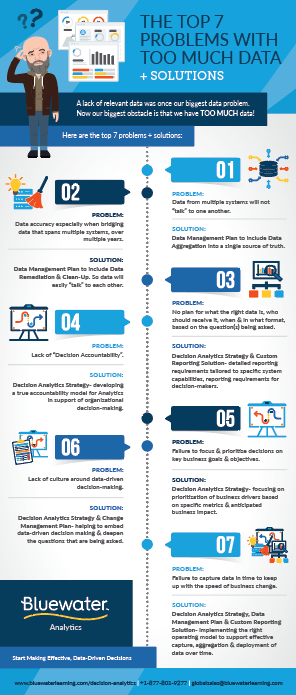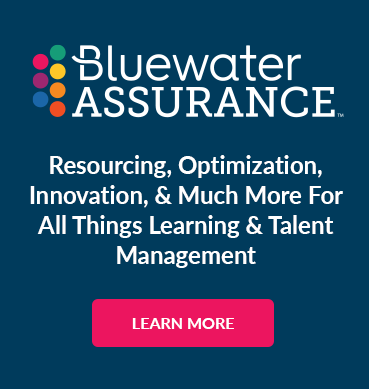The Problem with Data
by Chris Bond | August 7, 2019 07:38 AM | Shark Bites - Cornerstone Edition, analytics

There was a time, in the not-so-distant past, when simply finding data to address organizational needs was one of the most difficult tasks faced by HR. There was a constant need to accurately answer questions like:
- How many new hires do we have this quarter?
- How much money are we investing in benefits for our employees?
- Who is in or out of compliance?
- What is the ratio of contractors to employees?
- Who is certified to perform a specific task?
This gap has quickly closed in recent years with software applications and systems driving multitudes of data to our desktops, mobile devices, and reporting tools. Now, we have an even more complex problem than a lack of data – we have TOO MUCH data!
Data is coming in from a variety of sources: HRIS systems, learning management systems, performance management systems, employee engagement tools, survey tools, closed or open social media applications, 3rd party content providers – the list goes on and on. The questions that organizations are now asking have become more complex as we seek
- To understand what is happening across the enterprise institution
- To support immediate action (either corrective or reinforcing)
- To look at historical trends and make decisions designed to alter and improve business practices for the future
- To benchmark against the best practices, behaviors, and ideal business practices
As we ask ourselves more complex, open-ended questions and seek to make better, more confident, and data-driven decisions in response, a few key problems begin to rise up.
Data from multiple systems will not “talk” to one another
For example, there may be a need to combine sales data in Salesforce with customer feedback scores and compare that with individual employee development activities from an enterprise LMS to help determine which methods of employee training are working and which are not.
This data will emanate from a minimum of three different, disparate systems each with its own data language and organization. Is this a manual process or will it be fed into a 4th application specifically used for enterprise reporting (Power BI for example)? How will this data be combined and interpreted?
Data accuracy especially when bridging data that spans multiple systems & years
Lack of data governance is a key issue here with no uniform practices in place to address
- How data is entered, applied, and managed
- How data is retired, new data points created, etc.
- Common models, pre-set calculations, automation
- Security roles
- Consistency of interpretation
No plans for the data
When there is no plan in place for what the right data is, who should receive it when they should receive it, and in what format, this leads to the “Clay vs Granite” discussion.
Are we taking the bits of data we can find, and do we have confidence in pushing them together to see what we can learn? Much as we do with bits of clay to create something we want to see.
Or are we looking at all the data we might need to answer a question, analyzing what we have access to and confidence in, and then developing a plan to address gaps? Or at minimum, eliminate unnecessary data, leaving us with the pieces we need. Like chipping away unnecessary pieces from a block of granite to reveal the sculpture hidden inside.
Lack of “Decision Accountability”
If we provide data in support of decision-making, how do we know if the decision had the desired impact on the business? In other words, did it do what we thought it would? And how can we determine this sooner rather than later so that we can make informed adjustments before it is too late to matter?
Failure to focus & prioritize decisions on key business goals & objectives
We can get so caught up in driving data and making decisions based on what we see that we can easily lose sight of why we are making decisions in the first place.
Are we collecting data on how we pay people because we want to be sure that we are supporting equal pay within the organization or because we want to attract and retain talent more effectively? Or both? The business drivers will dictate the data we need and the specific questions we need to answer with it.
A key factor in prioritizing business needs is the “Cost of Doing Nothing.” What would it do to the business if we didn’t make any changes or eliminated this function altogether?
Lack of culture around data-driven decision-making
Many companies do not have a culture of data-based decision-making. Are key decision-makers naturally seeking data in support of the questions they are asking, without pre-supposing results? How do you know that you are moving towards a more data-driven, analytic culture?
It is most clearly evidenced in the types of questions that are being asked. For example, moving from wanting a simple completion report to wanting to understand and address organizational talent gaps. Like where there is a significant and critical need and not enough talent with the required skills to fulfill that need.
Failure to capture data in time to keep up with the speed of business change
By the time you are able to aggregate data from multiple sources, clean it so you are confident in its accuracy, and organize and deliver it in the right format to the people who need to see it, months may have passed. The business need and priorities may have been passed along with them.
How can we shorten the time from identifying key questions to the delivery of data in support of the answer while it is still relevant?
We used to think that finding data was the problem. Now that we have more data available than we ever imagined, new problems arise and must be addressed to promote effective data usage. Once we have a process and operational model in place for effective data-driven decisions, it can be transformational for your department, business, and industry.

Click here to learn more about Decision Analytics or feel free to reach out to us directly!
Search Our Blogs
Categories
- Ad Hoc (1)
- ADMIN (1)
- administration (1)
- AI (2)
- analytics (2)
- anxiety (1)
- Artificial intelligence (2)
- automation (1)
- BI (1)
- blog (1)
- Blueprint (1)
- center of excellence (10)
- Communication (2)
- COVID-19 (2)
- Culture (1)
- Custom Content (1)
- customer service (1)
- Data (1)
- Employee Engagement (1)
- Shark Bites - Cornerstone Edition (12)
- Shark Bites - SumTotal Edition (4)
- Shark Bites - Ultimate Edition (5)
- The Future of Learning (16)
- The Future of Talent Management (30)
- User Experience (2)
- UX (2)
- wellbeing (1)

